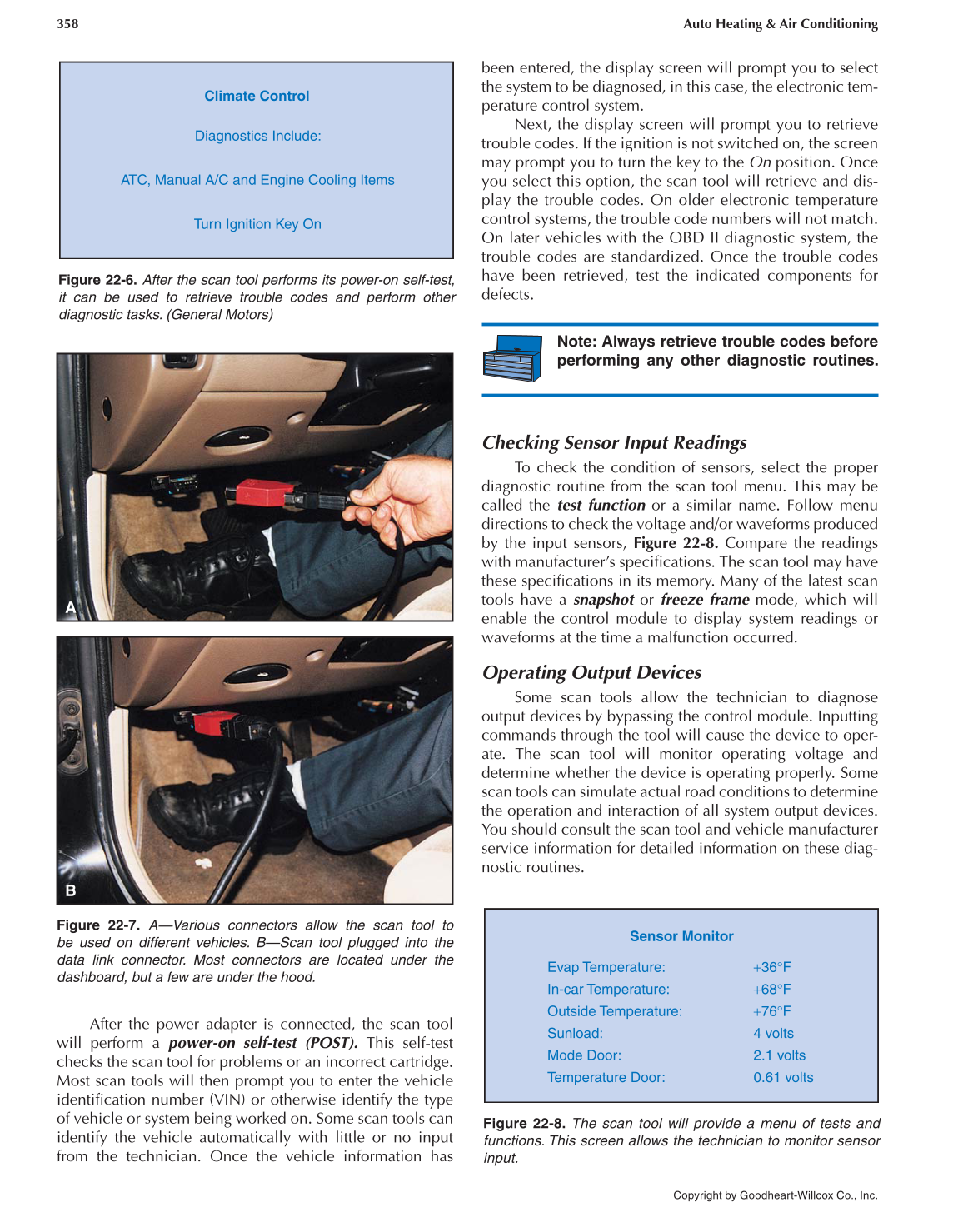358 Auto Heating & Air Conditioning
Copyright by Goodheart-Willcox Co., Inc.
After the power adapter is connected, the scan tool
will perform a power-on self-test (POST). This self-test
checks the scan tool for problems or an incorrect cartridge.
Most scan tools will then prompt you to enter the vehicle
identifi cation number (VIN) or otherwise identify the type
of vehicle or system being worked on. Some scan tools can
identify the vehicle automatically with little or no input
from the technician. Once the vehicle information has
been entered, the display screen will prompt you to select
the system to be diagnosed, in this case, the electronic tem-
perature control system.
Next, the display screen will prompt you to retrieve
trouble codes. If the ignition is not switched on, the screen
may prompt you to turn the key to the On position. Once
you select this option, the scan tool will retrieve and dis-
play the trouble codes. On older electronic temperature
control systems, the trouble code numbers will not match.
On later vehicles with the OBD II diagnostic system, the
trouble codes are standardized. Once the trouble codes
have been retrieved, test the indicated components for
defects.
Note: Always retrieve trouble codes before
performing any other diagnostic routines.
Checking Sensor Input Readings
To check the condition of sensors, select the proper
diagnostic routine from the scan tool menu. This may be
called the test function or a similar name. Follow menu
directions to check the voltage and/or waveforms produced
by the input sensors, Figure 22-8. Compare the readings
with manufacturer’s specifi cations. The scan tool may have
these specifi cations in its memory. Many of the latest scan
tools have a snapshot or freeze frame mode, which will
enable the control module to display system readings or
waveforms at the time a malfunction occurred.
Operating Output Devices
Some scan tools allow the technician to diagnose
output devices by bypassing the control module. Inputting
commands through the tool will cause the device to oper-
ate. The scan tool will monitor operating voltage and
determine whether the device is operating properly. Some
scan tools can simulate actual road conditions to determine
the operation and interaction of all system output devices.
You should consult the scan tool and vehicle manufacturer
service information for detailed information on these diag-
nostic routines.
Figure 22-6. After the scan tool performs its power-on self-test,
it can be used to retrieve trouble codes and perform other
diagnostic tasks. (General Motors)
Climate Control
Diagnostics Include:
ATC, Manual A/C and Engine Cooling Items
Turn Ignition Key On
Figure 22-8. The scan tool will provide a menu of tests and
functions. This screen allows the technician to monitor sensor
input.
Sensor Monitor
Evap Temperature:
In-car Temperature:
Outside Temperature:
Sunload:
Mode Door:
Temperature Door:
+36°F
+68°F
+76°F
4 volts
2.1 volts
0.61 volts
A
Figure 22-7. A—Various connectors allow the scan tool to
be used on different vehicles. B—Scan tool plugged into the
data link connector. Most connectors are located under the
dashboard, but a few are under the hood.
B
